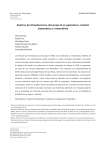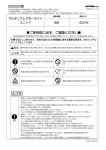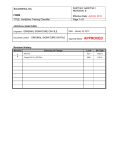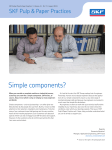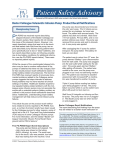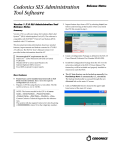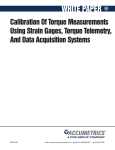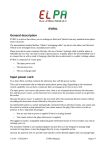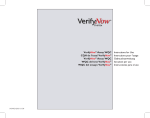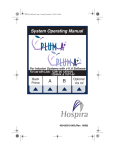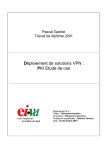Download VerifyNow PRUTest Package Insert - Accriva Diagnostics
Transcript
PN 14438.A.1 2012‐09‐14 Instructions for Use Technical Support: (US) 1‐800‐643‐1640 (Outside US) +1‐858‐643‐1600 MDSS: +1‐858‐643‐1600 ___________________________________________________________________ 1 INTENDED USE The VerifyNow PRUTest is a whole blood test used in the laboratory or point of care setting to measure the level of platelet P2Y12 receptor blockade. PRODUCT DESCRIPTION The VerifyNow System is a turbidimetric based optical detection system, which measures platelet-induced aggregation. The system consists of an instrument, a disposable test device and quality control materials. See Figure 1 for a representation of the test device. Quality control measures include an instrument based electronic quality control (EQC), two levels of wet quality controls (WQC), and internal quality controls. The instrument controls all test sequencing, temperature, reagent-sample mixing and performs self-diagnostics. The degree of platelet function is determined and the result is displayed. The test device contains a lyophilized preparation of human fibrinogen coated beads, platelet activators, and buffer. The patient sample is anticoagulated whole blood, which is automatically dispensed from the blood collection tube into the test device by the instrument, with no blood handling required by the user. PRINCIPLE The VerifyNow PRUTest is designed to measure platelet P2Y12 receptor blockade. Substances known to specifically block the P2Y12 receptor include the thienopyridine class of drugs, including clopidogrel. The test is based upon the ability of activated platelets to bind fibrinogen. Fibrinogen-coated microparticles aggregate in whole blood in proportion to the number of expressed platelet GP IIb/IIIa receptors. The rate of microbead aggregation is more rapid and reproducible if platelets are activated; therefore, the reagent adenosine-5-diphosphate (ADP/PGE1) is incorporated into the test channel to induce platelet activation without fibrin formation. The reagent is formulated to specifically measure P2Y12-mediated platelet aggregation. Light transmittance increases as activated platelets bind and aggregate fibrinogencoated beads. The instrument measures this change in optical signal and reports results in P2Y12 Reaction Units (PRU). 2 MATERIALS PROVIDED VerifyNow PRUTest devices individually sealed in foil pouches. Each test device contains lyophilized fibrinogen-coated beads, ADP, bovine serum albumin, PGE1, and buffer. REAGENT STORAGE AND HANDLING • Store test devices at 2° C to 25° C (36° - 77° F). • If refrigerated, allow test devices to reach room temperature, 18° C to 25° C (64° -77° F), prior to use. • Test device should remain sealed in the foil pouch until ready for use to prevent damage by humidity. MATERIALS REQUIRED BUT NOT PROVIDED • Greiner Bio-One Vacuette® partial fill blood collection tubes (2 mL fill volume) containing 3.2% sodium citrate. Greiner Catalog #454322 or Nipro catalog #NP-CW0185-1 blood collection tube (1.8 mL) containing 3.2% sodium citrate. • VerifyNow Instrument with Electronic Quality Control (EQC). • VerifyNow Assay WQC Kit, Catalog #85047. 3 PRECAUTIONS • For in vitro diagnostic use. • The VerifyNow Instrument and its components should only be used as directed in the User Manual. • Do not use the VerifyNow PRUTest device or WQC materials beyond the expiration date. • All patient samples should be handled as if capable of transmitting disease. • The reagents are manufactured with a material purified from human plasma that was found negative for all communicable diseases tested, including HIV-1, HIV-2, Hepatitis B surface antigen (HBsAg) and HCV. Handle test devices as biohazardous material and dispose of in an appropriate manner. SAMPLE COLLECTION AND HANDLING Instructions for Sample Collection from Indwelling Venous Catheters: 1. Whole blood samples that are obtained from an indwelling catheter should be collected after sufficient discard (approximately 5 mL) has been drawn to clear the line. Ensure indwelling catheter is free of clots. Transfer blood to the blood collection tube immediately after collection. 2. Gently invert the sample tube at least 5 times to ensure complete mixing of the contents. 3. Blood must set a minimum of 10 minutes after collection before testing but no longer than 4 hours. Instructions for Peripheral Samples: 1. Whole blood may be collected from venous sites using a 21 gauge or larger needle in an appropriate blood collection tube. Blood samples should be obtained from an extremity free of peripheral venous infusions. 2. Collect a discard tube first (approximately 2 mL). 3. Gently invert the sample tube at least 5 times to ensure complete mixing of the contents. 4. Blood must set a minimum of 10 minutes after collection before testing but no longer than 4 hours. 4 SAMPLE COLLECTION PRECAUTIONS • Fresh whole blood samples in the appropriate collection device are required for use with the VerifyNow Instrument. • If drawing blood for a CBC at the same time as sample collection for VerifyNow PRUTest, fill the CBC tube last. • Do not freeze or refrigerate samples. • Collection of the blood sample should be performed with care to avoid hemolysis or contamination by tissue factors. Samples with evidence of clotting should not be used. • Always ensure collection tubes are filled to the indicated fill volumes. At altitudes greater than 2500 feet above sea level, blood collection tubes may not fill to the specified volume, which results in an incorrect ratio of blood to anticoagulant. Users at these elevations should refer to their facility's blood collection protocols for instructions to properly fill blood collection tubes. • Samples should be collected and handled according to the institution's policies and procedures pertaining to biohazardous material. TEST PROCEDURE 1. Refer to the VerifyNow System User Manual for complete operating instructions. 2. Open the foil pouch and remove the test device. Test devices should only be handled by finger grip. (See Figure 1) 3. Remove the needle’s protective sheath by pulling directly up on the sheath. Do not twist the sheath as this may remove the needle. 4. At the instrument prompt, insert the test device into the instrument. 5. At the instrument prompt, gently invert the sample tube at least 5 times, and insert onto the needle in the test device. Close the test port cover. 6. The instrument will run the test and display the result in less than three minutes. CAUTION: Sample is under pressure. Do not remove sample tube from test device. Only remove test device from the instrument after test is completed. 7. Remove the test device by grasping the test device finger grip and pulling straight up. Do not remove the tube from the test device. Dispose of the entire test device/sample tube in appropriate biohazard waste container. REPORTED RESULTS • The VerifyNow PRUTest reports results in P2Y12 Reaction Units (PRU), which report the amount of P2Y12 receptor mediated aggregation specific to the platelet, and are 5 • calculated as a function of the rate and extent of platelet aggregation in the ADP channel. The VerifyNow instrument also allows the user to calculate a percent inhibition for a given patient provided that a baseline PRU value was obtained prior to administration of the drug. INSTRUMENT MESSAGES Under certain conditions, a test run may be aborted. In this case, the instrument will display an Error or Attention message. Please refer to the VerifyNow User Manual for a more detailed explanation of these messages. CALIBRATION VerifyNow PRUTest devices are calibrated at the factory. This calibration information is contained in the barcode on the pouch of each test device. The barcode must be scanned whenever a new lot of test devices is to be tested. If a new lot of test devices is being used, the instrument will prompt the user by displaying a barcode icon after the test device is inserted. • At prompt, place the test device pouch in front of the barcode reader found on the left side of the instrument, so that the barcode on the pouch lines up with the barcode reader. • An audible beep will be heard when the instrument receives the required information. • The user needs only to perform this action once per lot. QUALITY CONTROL • The manufacturer recommends that an Electronic Quality Control (EQC) be run once per day. This reusable device verifies instrument optics, pneumatics and reagent mixing. • The VerifyNow PRUTest also contains the following internal controls: - The instrument automatically verifies sample filling, correct fluid transfer, and mixing. It also monitors the electronic and mechanical components. - Each test device incorporates two levels of quality control to identify invalid test runs caused by random errors, reagent degradation, or inappropriate blood samples. Before platelet activation and fibrinogen binding begin, the negative internal control performs a test for nonspecific aggregation. - During the active phase of the test, the positive internal control channel monitors the reaction and calculates Control Units, which must fall within specified limits. A failure of the negative or positive control results in the reporting of an error message by the VerifyNow instrument, and no PRU result is reported. 6 Wet Quality Controls are available from Accumetrics for verifying the integrity of the VerifyNow System. VerifyNow PRUTest Level 1 and Level 2 WQC are formulated at clinically relevant levels and can be used as part of a laboratory quality control program. The manufacturer recommends that a Level 2 WQC be run once each time a new lot or a new shipment of VerifyNow PRUTest kits is received or every 30 days. VerifyNow Assay WQC (catalog number 85047) is available from Accumetrics. For questions regarding WQC materials call Accumetrics Technical Support at (800)643-1640 for assistance. TEST LIMITATIONS Delays in testing or difficulty of specimen collection may result in spurious values. The lyophilized reagent is hygroscopic and can degrade after prolonged exposure to room air. Therefore, the test device should be used shortly after removal from the foil pouch. When results are not within the expected limits, the possibility of improper sample collection or handling should be investigated. Repeat the test using a new test device and sample. Patients with inherited platelet disorders such as von Willebrand Factor Deficiency, Glanzmann Thrombasthenia and Bernard-Soulier Syndrome have not been studied with the VerifyNow PRUTest. The VerifyNow PRUTest is not intended for use with these types of platelet disorders. Patients with a known history of platelet counts <100 x109/L have not been studied. Patients who have been treated with Glycoprotein IIb/IIIa inhibitor drugs should not be tested until platelet function has recovered. This time period is approximately 14 days after discontinuation of drug administration for abciximab (ReoPro) and up to 48 hours for eptifibatide (Integrilin) and tirofiban (Aggrastat). The platelet function recovery time varies among individuals and is longer for patients with renal dysfunction. VerifyNow PRUTest results should be interpreted in conjunction with other clinical and laboratory data available to the clinician. SERVICE The VerifyNow Instrument is not intended to be serviced by the user. Instruments in need of repair are required to be returned to Accumetrics. If there are problems related to the VerifyNow System, call Accumetrics Technical Support at (800) 643-1640 (US) or +1 (858) 643-1600 (Outside US). 7 PERFORMANCE CHARACTERISTICS The VerifyNow PRUTest was evaluated in patients treated with clopidogrel, a drug known to specifically block the platelet P2Y12 ADP receptor (2, 6). The VerifyNow PRUTest was compared to platelet aggregometry using a CHRONO-LOG Optical Aggregometer (Light Transmittance Aggregometry - LTA) with 5 µM ADP as the agonist. The unit of measure for the VerifyNow PRUTest is PRU and is based upon both the rate and extent of platelet and fibrinogen coated beads binding over a defined period. The clinical trials were designed to obtain samples at two time points: 1) Baseline, prior to clopidogrel ingestion; 2) either 24 hours post ingestion of a single 450 mg loading dose, or post ingestion of 75 mg a day for at least 7 days. For each patient, a baseline and post ingestion (24hour or 7 days) sample was measured by each test method and the results were recorded. EXPECTED VALUES The VerifyNow PRUTest was performed in clinical studies at 3 centers on subjects with a history of vascular disease or two of eight risk factors for developing vascular disease as noted in the American Heart Association criteria (current or previous history of smoking, hypertension, hyperlipidemia, family history of vascular disease, post-menopausal females, diabetes mellitus, morbid obesity or sedentary lifestyle). Testing was performed on samples from 147 patients with planned treatment with clopidogrel.1 PRU Figure 2 shows the distribution of PRU values in patients before and after clopidogrel administration. The VerifyNow PRUTest measured changes in PRU after clopidogrel administration ranging from a minimum of 18 PRU to a maximum of 435 PRU with a mean change of 185 PRU. Reference Range Table 1 describes a reference range for the VerifyNow PRUTest that was calculated at the 95% confidence level for the baseline (pre-clopidogrel) dataset, using CLSI Guideline C28-A2. 8 ANALYTICAL PERFORMANCE Method Comparison In order to compare the clinical PRU and LTA results, post-clopidogrel data are expressed as percent inhibition, or percent reduction from baseline. The calculation is as follows: % Reduction = (Baseline PRU – Post PRU) X 100 Baseline PRU Based on the clinical study results (n=147), the percent reduction from baseline (% RED) for the two tests are correlated (r = 0.685), and a regression analysis of these two variables results in the following model. % RED( PRU) = 32.941 + 0.778 X % RED(LTA). The equation shows that the PRU values demonstrate a much greater percent reduction than those for LTA. This is the result of the non-specificity of LTA, using ADP, for the P2Y12 receptor. Using the linear relationship above and the 95% confidence limits of the points on the line as a starting point, percentage reductions in PRU were correlated with percentage reductions in LTA in a way that would produce the highest degree of agreement using Cohen's kappa as a measure of agreement. For various percent reduction values for LTA between 10 and 50%, corresponding percent reduction values were calculated for PRU. Using each pair of percents as cutoff values, 2 x 2 tables were prepared to assess agreement of the two methods for the 147 study subjects. Agreement between LTA and the VerifyNow PRUTest was much better than can be attributed to chance alone as measured by Cohen's kappa. For LTA values above 30% reduction from baseline, Cohen's kappa was greater than 0.4, a value considered as evidence of good agreement by Landisand Koch (7). Across the entire range, the specimens considered low or high by both methods, a measure of overall agreement, was between 75 and 80%. Test Specificity The VerifyNow PRUTest is formulated to have greater specificity for platelet aggregation mediated by the P2Y12 receptor than the P2Y1 receptor, both of which are activated by ADP. Thus, LTA using ADP as the agonist is affected by both platelet ADP receptors P2Y1 and P2Y12. (Figure 3) Since clopidogrel acts only on the P2Y12 receptor site, LTA has a non-specific aggregation artifact due to P2Y1 mediated aggregation (6) that is not seen in the VerifyNow PRUTest. To accomplish the goal of having a test with reduced non-specific aggregation, the VerifyNow PRUTest uses an additive (PGE1) in addition to ADP to make the test more sensitive and specific for the effects of ADP mediated by the P2Y12 receptor. 9 The following data illustrate the effect of PGE1 on LTA test specificity to the P2Y12 receptor. Blood was drawn from 10 individuals, and a known specific P2Y12 inhibitor, 2-methylthio-AMP (2MeSAMP), was added to each blood sample at a concentration to achieve near maximal inhibition. LTA was performed using 10 µM ADP, with and without addition of PGE1. The VerifyNow PRUTest was also run on these samples. Figure 4 shows that for all ten blood donors, the percent inhibition (% decrease in aggregation) is less for aggregometry with ADP only (73% avg inhibition) than for aggregometry with ADP and PGE1 (95% avg inhibition). In addition, agreement between the VerifyNow PRUTest and LTA using PGE1 was very good (93% vs 95% avg inhibition). This study demonstrates the benefit of using PGE1 to achieve greater P2Y12 specificity. Precision Simple and complex precision were determined according to CLSI precision guidelines, using three lots of VerifyNow PRUTest devices.. For complex precision, whole blood was drawn from volunteer donors and duplicate measurements in two runs per day were performed over 20 days. The within-run CV presented in Table 2 is defined by CLSI as the within-run precision value. Preliminary (Simple) precision was determined for the VerifyNow PRUTest wet quality control Level 2. Three lots of test devices were each tested 20 times using a single lot of control.The results are provided in Table 3. Interfering Substances Laboratory testing was performed to determine the effect of several classes of drugs on VerifyNow PRUTest results. • Certain drugs that inhibit platelet function affect the results of the VerifyNow PRUTest. • Glycoprotein IIb/IIIa inhibitors abciximab, eptifibatide, and tirofiban significantly affect VerifyNow PRUTest results. See LIMITATIONS section for details. • Cilostazol may affect VerifyNow PRUTest results. The average duration of its platelet inhibitory effect is 12 hours. • Drugs that affect platelet function may be detected up to 14 days after ingestion. • Other classes of commonly used drugs were tested with no significant effect on VerifyNow PRUTest performance, including: antioxidants, ACE inhibitor, antiarrhythmics, anticoagulants, aspirin, antidepressants, insulin, allopurinol, alcohol, beta blockers, bronchodilators, calcium channel blockers, gastrointestinal medications, betamethasone, lovastatin, NSAIDs (including COX-1 and COX-2 enzyme inhibitors), and the thyroid hormone L-thyroxine. The thrombolytic agent streptokinase showed no significant inhibition of platelet function, as measured by the VerifyNow PRUTest. 10 • Test performance was not affected by hematocrit values between 33-52%, or platelet count values between 119,000 -502,000/µL. • No significant interference was observed on samples studied with triglyceride concentrations between 41-824 mg/dL. No significant interference was observed on samples studied with cholesterol concentrations between 98-316 mg/dL. • No test interference was observed when samples with fibrinogen levels between 171 and 599 mg/dL were tested with the VerifyNow PRUTest. Tables and Figures FIGURE 1 Test Device 1 11 FIGURE 2. PRU results pre‐ and post‐clopidogrel FIGURE 3. Platelet activation by ADP. 12 % Inhibition FIGURE 4. % Inhibition with P2Y12 Specific Inhibitor VerifyNow PRUTest vs. Light Transmittance Aggregrometry 100% 90% 80% 70% 60% 50% 40% 30% 20% 10% 0% LTA ADP LTA ADP/PGE1 PRUTest VN P2Y12 Donor ID 13 Table 1: Reference Range Table 2. Complex Precision Statistics as Defined by CLSI Complex Precision Statistics as Defined by CLSI Complex Precision WithinTotal Whole Blood Run (Simple) Description n n Mean SD CV SD CV% (days) (results) % Male 20 80 284 21.4 7.5 21.4 7.5 Age 48 Male 20 80 175 9.2 5.3 17.5 10.0 Age 29 Table 3 Preliminary (Simple) precision *The manufacturer’s specification for the coefficient of variation is ≤10%. 14 Bibliography 1. Bhatt D, Topol.EJ. Scientific and Therapeutic Advantages in Antiplatelet Therapy. Nature Reviews 2003(2): 15. 2. Schulman S. Antiplatelet Therapy in Non-ST-Segment Elevation Acute Coronary Syndromes. JAMA 2004; 292(15): 1875. 3. Gurbel PA, Bliden KP, Zaman KA, Yoho JA, Hayes KM, Tantry US. Clopidogrel loading with eptifibatide to arrest the reactivity of platelets: results of the Clopidogrel Loading With Eptifibatide to Arrest the Reactivity of Platelets (CLEAR PLATELETS) study. Circulation 2005 Mar 8; 111(9): 1153- 9. 4. CAPRIE Steering Committee. A randomised, blinded, trial of clopidogrel versus aspirin in patients at risk of ischaemic events (CAPRIE). Lancet 1996; 348: 1329-39. 5. Michelson AD. Platelet function testing in cardiovascular diseases. Circulation 2004 Nov 9; 110(19): e489-93. 6. Geiger J, Teichmann L, Grossmann R, Aktas B, Steigerwald U, Walter U, Schinzel R. Monitoring of Clopidogrel Action: Comparison of Methods. Clin Chem 2005 April 7; 51(6). 7. Landis, R. and G. Koch. The measurement of observer agreement for categorical data. Biometrics 33:159-174, 1977. 8. Aleil B, Ravanat C, Cazenave JP, Rochoux G, Heitz A, Gachet C. Flow cytometric analysis of intraplatelet VASP phosphorylation for the detection of clopidogrel resistance in patients with ischemic cardiovascular diseases. J Thromb Haemost. 2005 Jan;3(1): 85-92 15 Explanation of Symbols Lot Numbe r Catalo g Numbe r In Vitro Diagnosti c Use Authorized Representativ e in the European Community OriginHuman Manufactur er Use By Accumetrics, Inc® San Diego, CA 92121 Accumetrics (US): 1-800-643-1640 Accumetrics (Outside USA): +1-858-643-1600 Celebrex® is a registered trademark of Pharmacia, Peapack, NJ Vacuette®is a registered trademark of Greiner, Kremsmeunster, Austria ReoPro®is a registered trademark of Eli Lilly and Company Integrilin®is a registered trademark of Millennium Pharmaceuticals, Inc. Aggrastat® is a registered trademark of Medicure International, Inc. U.S. Pat. D 409.758 and Others Pending 16 Temperatur e Limits Caution: Consult accompanyin g documents Contains sufficient for 25 tests
















